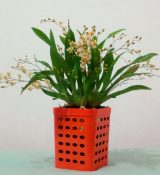How to Grow and Maintain Orchids During the Winter Months
Author: Celeste Booth2 Comments
Care and Culture, Growing Indoors
The northern half of the US gets really cold each winter.
For about half of the nation the temperatures dip well below 55 degrees fahrenheit (and much colder the more north you go). For orchid enthusiasts that means it’s time to prepare for winter care.
The majority of orchids require temperatures between 55 and 80 degrees. There is no way to keep these particular orchids outside when the cold winds blow own from the north. It doesn’t mean you have to give up on your favorite orchids for the year, though. There are plenty of ways to bring them indoors and maintain and even grow orchids so that by the springtime there is plenty of reason to rejoice.
Here is the rundown of how to care and grow orchids during the winter months in the middle and northern areas of the United States. For the orchid enthusiast, some of these instructions will be familiar, but please add your tips and tricks for caring for orchids in the wintertime.
Orchids Indoors During Winter
There are a few quirks to keeping your orchids indoors during the winter months. You’ll need to find the right places to keep them to provide the proper amount of light while making sure your house or apartment is kept at the proper temperature. Taking care of orchids indoors takes a twist with things like setting your orchid near a window for additional light. However, doing so during the really cold days could mean that the temperature near the window is too cold, thus harming the orchid.
While there are a few intricacies of keeping your orchids indoors during winter it’s very rewarding to have your favorite flowers make it through the cold months and bloom fully come spring and summer. With a few careful considerations it can become easier to care for your orchids.
Light
Proper sunlight is key for orchid health.

Yellow Orchid
In the outdoors, orchids consume 14 hours or more of natural light. This is typically ideal for the high intesity orchids like Cattleya and Epidendrum among others. A good 12 to 14 hours of natural light is ideal, but difficult in most northern parts of the US during the winter months. If you live in an arear where natural light is difficult most days during winter you’ll have to look at artificial growing lights. You can set these up in your home and use them to help the natural light coming through the windows and glass doors in your home.
You can typically find growing lights of good quality for under $100 and even under $50 in the right circumstances. If possible, get lights that will last for many seasons. It’s worth spending a little extra today if you plan on growing your orchids indoors during the winter months for many years. Reliable equipment gives you peace of mind and will have your flowers primed for return to the outdoors during the summer.
Light is usually the biggest concern when bringing your orchids indoors for the winter months. Outside of a true greenhouse, it’s possible for orchids to get plenty of light during winter, but sometimes it requires a little extra effort to get the most out of your orchids.
As mentioned earlier, though, it’s important to consider the impact the heat loss around glass will have on your orchids as well.
Temperature
As mentioned above, when the temperature dips below 55 to 60 degrees, it’s necessary to bring your orchids indoors for the winter. Something often overlooked in the winter care of orchids is the balance of heat needed for orchids with the requirement to keep indoor temperatures pleasant and cost efficient for you and your family.
Most people keep their homes in the mid to upper sixties during winter. This is great for sleeping and preserving money used for energy costs yet it is not ideal for orchids. While the temperature is above 60 degrees, orchids can not be sustained in that temperature. They can handle it for a little while, but any prolonged exposure for a few months during the winter should include temperatures in the 70s. One option might be to set aside a special area in your home for higher temperatures. In modern homes, zoned heating is one option while portable heaters could be another, less expensive way to provide ample heat for your plants.
Windows can be tricky business for winter growing. Windows are needed to provide plenty of light for orchids during the winter months yet these windows can play games with the temperature of the orchid. Too much exposure to the window during cloudy days or at night can lead to damage on the plant when the temperatures get too cold. Be aware of how much the temperature can change near your windows. If it’s too cold during the night it can lead to damage and the converse is true as well. If the sun is beating through the window it can heat up the air surrounding your flower and lead to damage as well.
Keep the temperature around your orchids as even as you can. It’s difficult, but when managed correctly you’ll see healthy and growing flowers as the winter months wear on and the springtime nears.
Water
Watering is a big concern with orchids.

White Orchid
In most cases, improper water care leads to most orchid issues with growers. Watering of orchids can be tricky because of the all the variables involved. It makes sense that even professionals can struggle to find the right watering routines for orchids.
Humidity, air quality, and other factors come into play with orchids and the necessary watering. It’s important to water orchids as their soil just dries out. The air is typically more dry in the winter months even if you control it with a humidifier. This will cause different watering schedules for your indoor orchids. You can spend a little more time learning the drying periods of your plants in the early parts of winter and learn what routine you can comfortable work with for the rest of the winter.
When watering, fill the pot up until water drains from the drainage areas. This will ensure the soil has time to soak up the water and also flush out anything in the soil that might be detrimental to the plant. It’s another case of balancing enough water while not completely drowning the orchid. It takes time and patience to find the right balance for your specific type of orchid.
Watering is important during the winter as it is year round. You’ll have to spend time monitoring the dryness of your orchids and make sure you water just as they dry while providing the right amount of water so they can thrive indoors.
Ventilation
Air quality and movement is an issue with most indoor plants.
Insects, bugs, and other issues arise when the air becomes stale. When you close the windows and doors for the winter to keep the cold out, the air can become stale and lose quality. It’s difficult for humans and difficult for plant life as well.
A fan is a great solution to keep air moving in a home where ventilation and air quality are of concern in the winter months. Even modern homes with their airtight construction need proper ventilation both for humans and plants. If you’re home is closed off in the winter then it’ll be important to consider a fan for your plants.
Make sure to point the fan in the opposite direction of the plants. You can pull the air away from the area around the plant and keep things moving and ventilated in the area where you keep your plants. Be sure to turn any overhead fans to pull air up away from the plant or keep plants away from the direct blowing of a fan that blows hot air back down to the floor.
The circulation of the air in the room and proper ventilation is important for orchid success in the winter. Think about your specific situation and come up with a plan that will work best for your family and your plants.
Beyond Basic Care
Fertilizer is a good option if you want a little extra help with your orchids. Be sure to add the fertilizer when the potted soil is moist. This will allow the fertilizer to take effect. Don’t use too much. A little fertilizer will work just fine on most orchids. Dur winter, fertilizing isn’t more important as some may think. You can actually use it less frequently during the winter months to allow the plants to be more stable and rest rather than focus on growth.
Greenhouses are great and optimal for the winter months if you’re growing orchids. If you have a greenhouse you are likely well prepared to care for orchids during any winter months. Greenhouses can be constructed for relatively inexpensive funds and effort, but to construct one that will last for many winters it can take more resources. If you’re serious about growing orchids in the northern areas of the country it could be part of your long-term goals to construct a proper greenhouse. Remember to research the proper orientation to allow for the best sunlight. There will have to be another advanced article on growing orchids in greenhouses.
Summary
Taking care of orchids in the winter is crucial for their health.
Growing orchids is fun and fulfilling. Don’t let the winter blues set in. It can be fun and easy to bring your flowers indoors for the winter months and have them healthy and ready to go back outdoors when the temps warm up.
Focus on the basics of indoor and winter care and you’ll be set to go:
- Light
- Temperature
- Water
- Ventilation
Do you have any additional tips for fostering orchids indoors during winter?
Please share your thoughts with the orchid community.
2 Responses to “How to Grow and Maintain Orchids During the Winter Months”
Leave a Reply


Ask an Expert
Questions about orchids?
Our experts love a challenge!
Photo of the Week
Submit your photo to be featured on the blog!
More Photo of the Week Winners
Submit Photo








When it is necessary to repot orchids, or is that a no-no? If so, how is it done?
Donna it is best to repot after they are finished blooming. Typically potting only needs to happen every couple years to replenish the broken down potting medium.